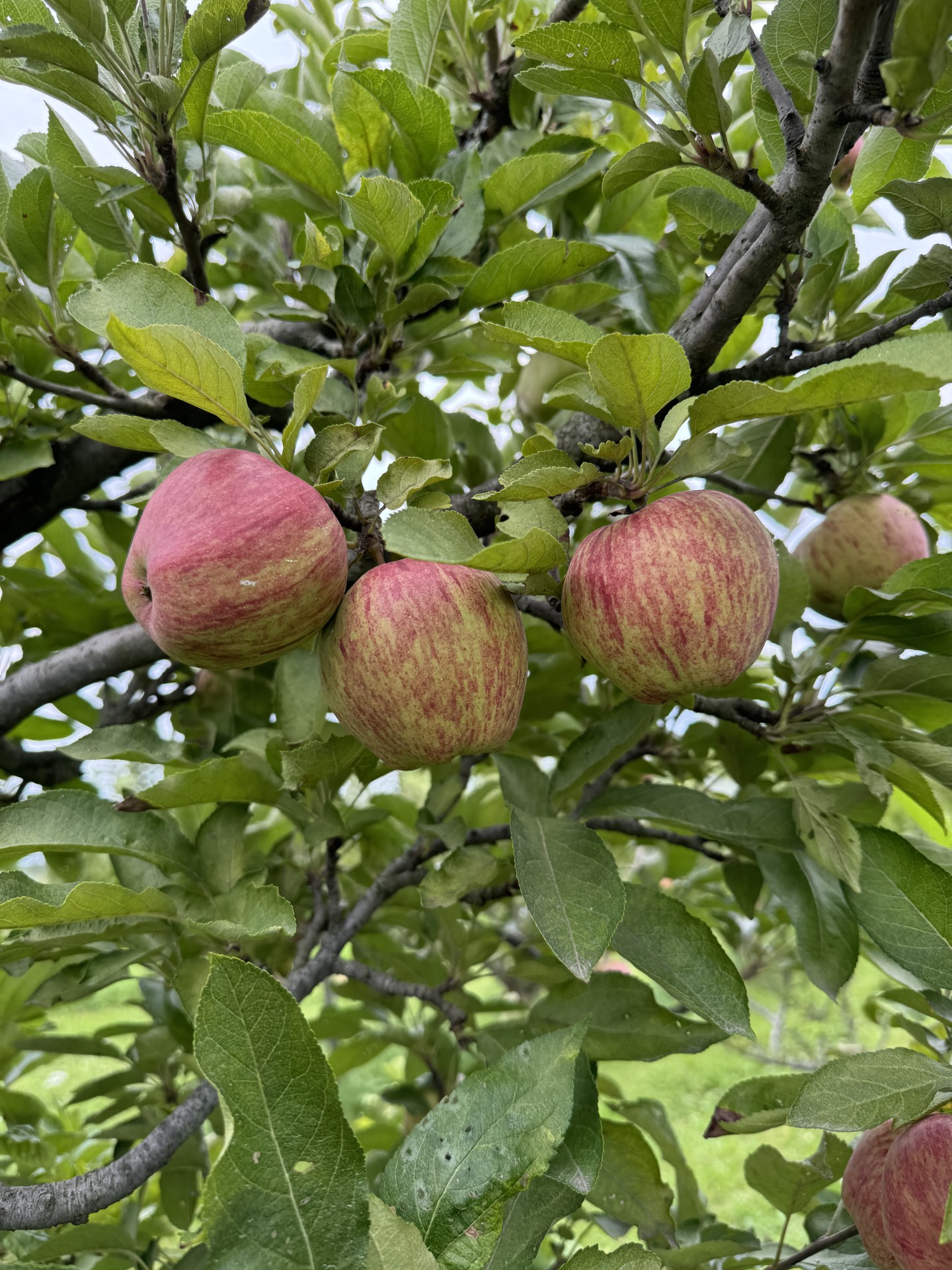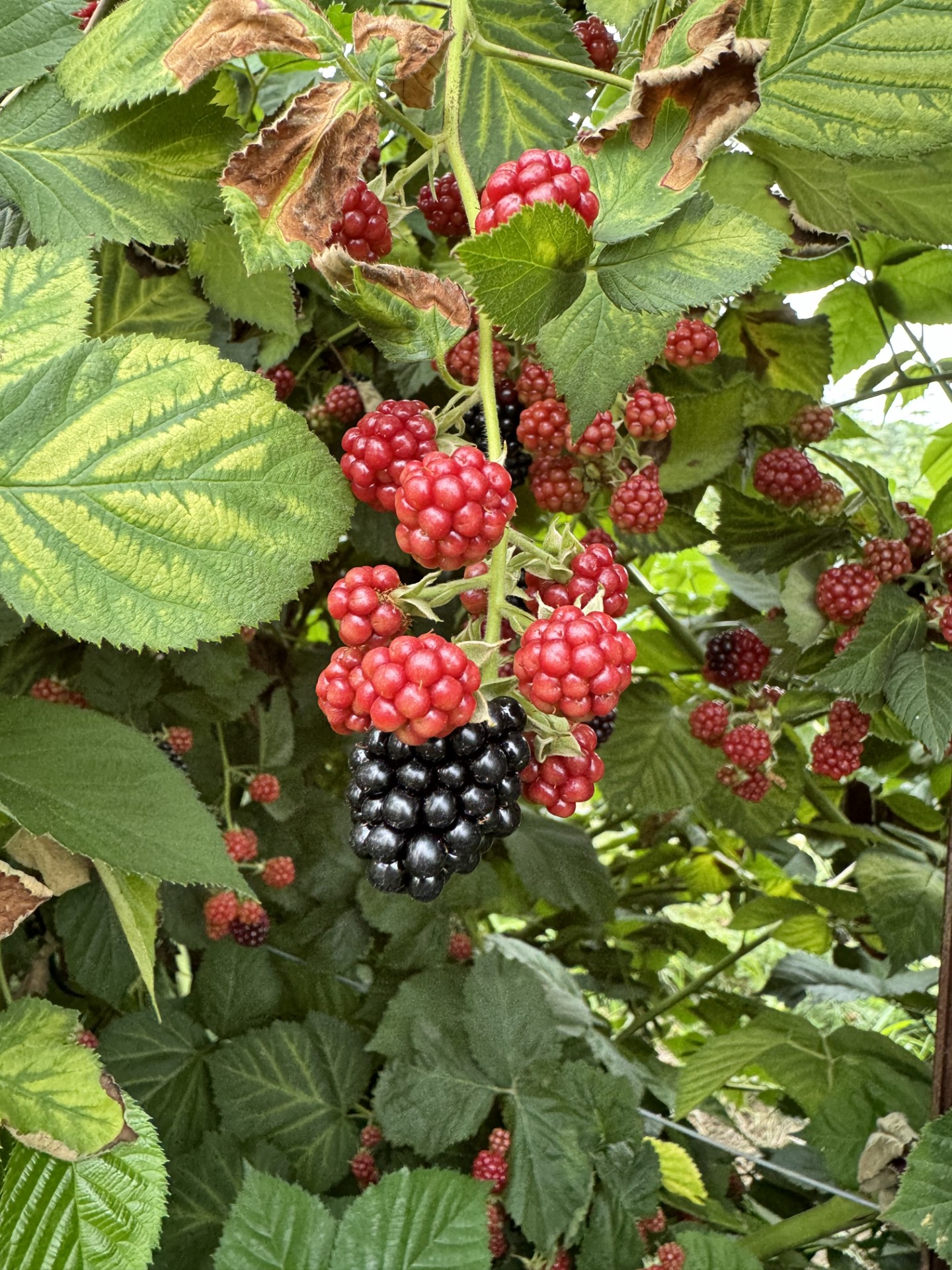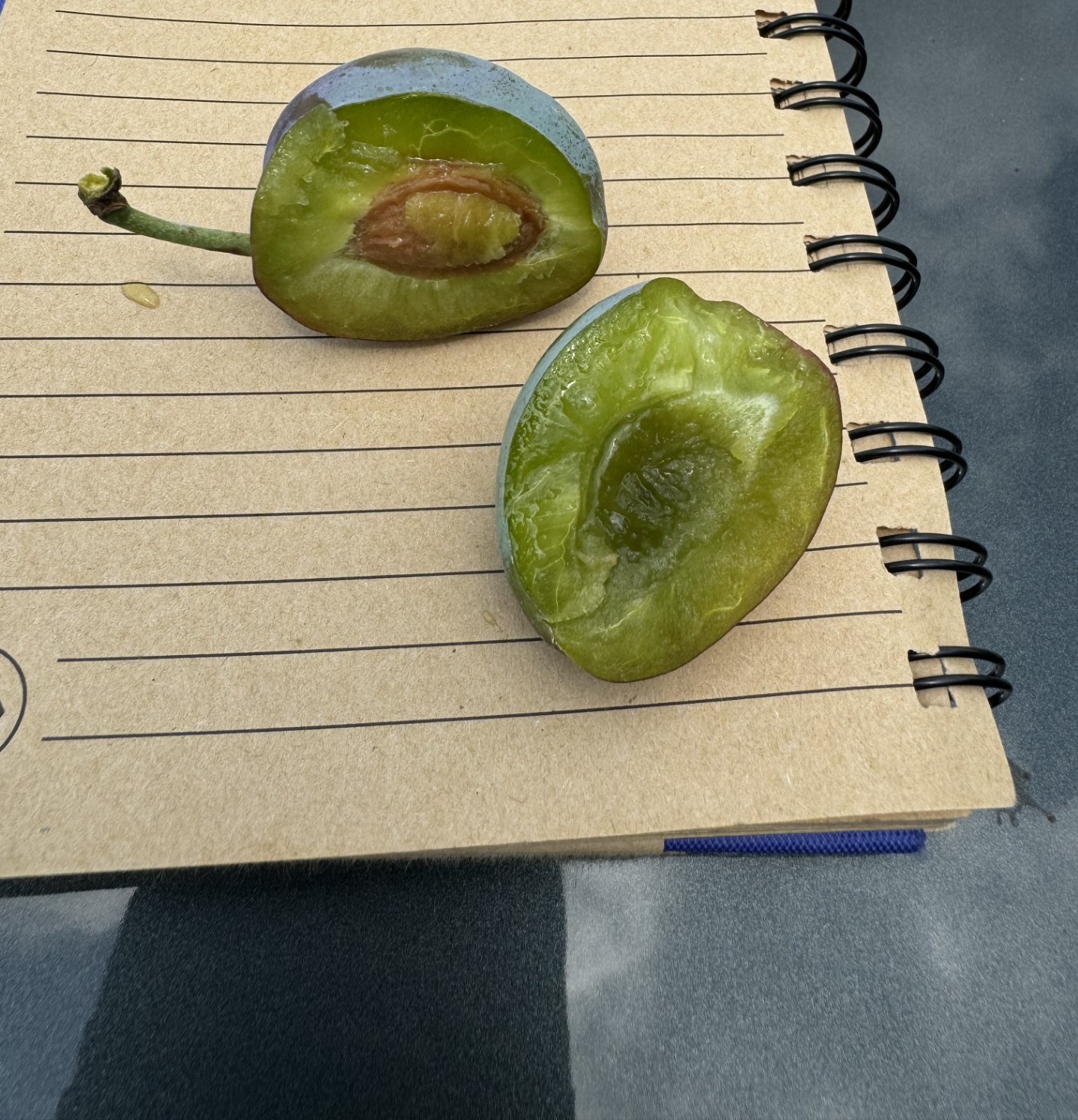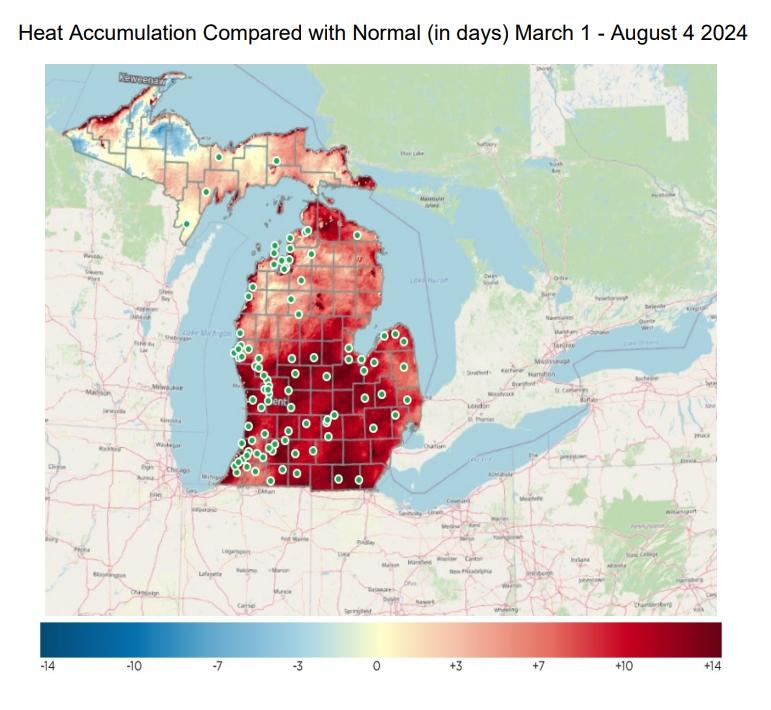Southeast Michigan fruit update – August 5, 2024
More grape varieties hit veraison while Red Haven peach harvest and early apples continue.

Welcome to the 14th in-season fruit article update for southeast Michigan for the 2024 season. Throughout the season these updates will include information about the weather in the past week and the upcoming week, a fruit-by-fruit guide to current conditions with appropriate pest and disease updates, and other relevant observations.
General observations
In the two weeks since the last update, many farms have hit peak peach harvest, with some already wrapping up Red Haven harvest and moving into later cultivars. Some table grapes have followed cold hardy wine grapes into veraison. Blueberry harvest continues in its late stages while early season apples ramp up.
We’ve seen an average of 1.2 inches of rain in the region over about 15 hours of rainfall in the last two weeks while temperatures have been sitting above normal. When using Enviroweather and other weather models, keep in mind that the weather station closest to you may have different topography or be in the path of weather events that pass by your location. The legacy version of Enviroweather is currently unavailable, so for the time being it is necessary to use the newer version of the site. A virtual training was offered on using Enviroweather on Friday, June 26, and the recording can be found here.
After today’s rain, we are expecting cooler temperatures and clear conditions for the next week with showers possible over the weekend. Temperatures will peak in the mid-70s and we could see lows in the upper 40s overnight with the rest of the week seeing lows in the 50s and 60s. You can see you an overview of disease risks on the RimPro interactive location chart. Make sure to check the models frequently as they change with weather forecasts.
It has been a relatively quiet two weeks on the insect front. We are starting to see a few brown marmorated stink bugs show up in orchards, which can be challenging to control because of their activity close to harvest. See this linked factsheet on managing brown marmorated stink bug. Spotted wing drosophila pressure is very high this year across the state in blueberries and brambles. Low trap counts do not necessarily correlate with low presence in fruit. Regional counts for codling moth are climbing again while those for oriental fruit moth are down. Low counts of apple maggot continue to be caught in some orchards. Secondary scab pressure remains low and powdery mildew seems to have been kept under control, but the risk of powdery mildew in tree fruit and grapes remains high for the entire week.
Fruit-by-fruit conditions
Apples
Apples in the region are generally in the 75-80 millimeter (mm) range. We’ve moved through the very early varieties and expect ‘Paula Red’ and “Ginger Gold’ to be ready this week. We are only about three weeks away from our predicted ‘McIntosh’ harvest dates for warmer parts of the region. You can see our predicted harvest dates for Southeast Michigan at this link. We expect high infection probability for powdery mildew the entirety of the next week.

Blueberries
Blueberry harvest continues but is starting to slow down. Anthracnose pressure has been high on the west side of the state, as has spotted wing drosophila (SWD). See our Michigan State University (MSU) Extension collection of factsheets and videos on SWD.
Brambles
Blackberry growers have been picking ripe fruit for a couple weeks already. Summer-bearing raspberry u-picks have closed, but to we expect fall-bearing raspberries to be harvested earlier than normal. Spotted wing drosophila has been caught in the region. See our MSU Extension collection of factsheets and videos on SWD.

Cherries
Harvest has wrapped up in both tart cherries and sweet cherries. There have been reports of problems with both cherry fruit fly and spotted wing drosophila and some growers have asked about SWD control post harvest. A 2017 MSU bulletin on SWD reports, “At the end of harvest, cherries, especially tart cherries, should not be left on the tree as SWD readily infest them leading to increasing pest densities. Additionally, there is evidence that flailing or otherwise crushing dropped fruit will help reduce post-harvest opportunities for SWD infestation, build-up and movement to adjacent orchards.”
Grapes
We saw veraison in ‘Marquette’ start around July 18 in Romeo. Table grapes including ‘Vanessa,’ ‘Venus,’ ‘Mars’ and ‘Fredonia’ have also started veraison at sites in Britton and Romeo. Some growers have started to put bird netting up around higher value varieties. Diseases of concern include powdery mildew, black rot and Phomopsis.
Strawberries
Harvest has finished. Renovation should begin as soon as you are done harvesting. This is an important step to ensure continued productivity next season. Read this 2023 article on strawberry renovation for additional information.
Peaches and nectarines
We are at peak peach season, with some farms already done harvesting ‘Red Haven’ and moving into later cultivars. There have not been many reports of brown rot issues.
Pears
‘Bartlett’ pears observed in Fenton were at 75 mm and starting to take on some color on Aug. 5. Some sooty blotch has been seen, which is a problem exacerbated by pear psylla.
Plums
Italian plums were fully changed in color with hardened pits in Romeo on Aug. 5. Brown rot control is critical around the time of fruit coloring and there may still be time for control in cooler parts of the region.

Insect conditions
Our mid-summer insect conditions remain relatively consistent from week to week and the last few weeks have been pretty quiet. In tree fruit our insect concerns include codling moth, apple maggot, and brown marmorated stink bug. In small fruit spotted wing drosophila remains the biggest concern.
Aphids: While some aphids are best controlled during dormancy, woolly apple aphids are controlled during the season. Woolly apple aphids have moved towards terminals, which is a transition that happens in mid-summer. See linked articles for more information. Aphids can stunt shoot growth and pave the way for secondary fungal infections like sooty mold. Many growers have gotten woolly apple aphids under control and infestations seem light this year. Some light infestations of green apple aphids have been reported by scouts.
Brown marmorated stink bug: Scouts are reporting a few brown marmorated stink bug adults in orchards that have historically had problems. See this factsheet on managing brown marmorated stink bug in Michigan orchards.
Borer complex: Lesser peachtree borer numbers are climbing in Fennville while greater peachtree borer and dogwood borer have declined to zero. You can read about the current status of Lorsban in this 2024 update. See the 2024 Fruit Management Guide and the article “Timing trunk sprays for the borer complex in cherries.” While chlorpyrifos is available for use this season, alternatives materials may be used to manage borers as well. Assail is a recommended material for a trunk spray once adult borers are active.
Codling moth: Codling moth catches have been climbing in southeast Michigan but remain on the low side. You can track the codling moth model on Enviroweather.
Grape berry moth: Grape berry moth catch is down to zero in Fennville, indicating that we are between generations. Control is usually most effective in the second and third generations.
Japanese beetle: These are generalist feeders with a single generation per season. They have been seen in apple orchards in the region but we seem to be past the peak. If needed insecticides can be used to control populations.
Oriental fruit moth: Counts are stable in Fennville but have remained low in southeast Michigan. If control for the first generation wasn’t effective sprays may be needed to control egg laying and larvae in the subsequent generation.
Pear psylla: This may need control throughout the season
San Jose scale: Characteristic spots on fruit are starting to appear in some locations. Male SJS counts have increased over the last couple weeks in Fennville. See the fruit guide.
Spotted wing drosophila (SWD): SWD are still be caught in traps and larvae are still being found in fruit. Trap counts don’t necessarily correlate with crop pressure- high pressure can exist with low trap counts.
Disease conditions
Apple scab: We are at the end of primary scab season and this week has a low probability of secondary scab infection. Scab pressure seems light this year.
Brown rot: This disease affects stone fruit and can proliferate during bloom. There may still be time to control in later varieties starting three weeks before harvest when fruits start to color, but be mindful of pre-harvest intervals.
Cherry leaf spot: We expect risk of infection on Aug. 6 and 9. See this 2013 article on cherry leaf spot management.
Fire blight: Some fire blight strikes have been reported in orchards that have had fire blight in past years, but there do not appear to be many new infections this year. Read this 2020 article from George Sundin for fire blight management options.
Fruit rots: Rots like bitter rot and black rot can be controlled as early as first cover in apples. Humid, warm nights like the ones we have been experiencing activate infections
Grape black rot: There is not much infection risk this week. See this 2014 article for grape black rot management options and consult E-154.
Orange rust: Orange rust continues to be a potential problem in brambles. Read the linked article for control options.
Peach leaf curl: Control needed to be done before bud break. The next chance to control it will be with fall sprays.
Phomopsis: In blueberries the Phomopsis fungus is active from bud swell until after harvest. Phomopsis has been seen in grapes in the region.
Powdery mildew of apple and pear: You can start to include products labeled for powdery mildew in sprays starting at tight cluster. There is a high risk of infection the entire week.
Powdery mildew and downy mildew of grape: Scouting should start early for these diseases. There is risk of powdery mildew infection on Aug. 6 and from the 10-15 in the region with downy mildew infection risk peaking Aug. 6. Read the linked article for control options.
While not a disease, nutrient deficiencies can leave plants more susceptible to disease. Now that the plants have leafed out you can start to see some symptoms. They can be hard to definitively diagnose without nutrient testing, but this article from Eric Hanson is a handy guide to what nutrient deficiency symptoms look like.
Seasonal weather update
In the last two weeks, we saw about 15 hours of rain accumulating to 1.2 inches of precipitation. We are ahead of the five-year average in both time and amount of rainfall.
| Liquid Precipitation Accumulation Jan. 1 - August 5, 2024, issued August 5, 2024 | ||||
|---|---|---|---|---|
| Station (County) | Rainfall Total (in.) Current | Hours with Rainfall Current | Rainfall Total Average (5 Yr.) | Hours with Rainfall Average (5 Yr.) |
| Commerce (Oakland) | 24.0 | 339 | 18.8 | 318 |
| Deerfield (Monroe) | 21.1 | 360 | 18.0 | 324 |
| East Lansing MSU Hort (Ingham) | 19.8 | 331 | 17.6 | 307 |
| Emmett (St. Clair) | 18.3 | 357 | 16.8 | 343 |
| Flint (Genesee) | 22.0 | 362 | 18.3 | 317 |
| Freeland (Saginaw) | 15.8 | 281 | 13.2 | 272 |
| Hudson (Lenawee) | 20.5 | 351 | 18.1 | 333 |
| Ithaca (Gratiot) | 16.9 | 385 | 17.0 | 302 |
| Lapeer (Lapeer) | 20.8 | 429 | 16.7 | 316 |
| Linwood (Bay) | 18.9 | 317 | 16.6 | 285 |
| Pigeon (Huron) | . | . | . | . |
| Richville/Frankenmuth (Tuscola) | 20.4 | 324 | 16.3 | 278 |
| Romeo (Macomb) | 23.8 | 348 | 18.4 | 302 |
| Sandusky (Sanilac) | 16.6 | 415 | 14.8 | 301 |
| Average of stations in this region: | 19.9 | 353.8 | 17.0 | 307.5 |
| Difference in Liquid Precipitation Accumulation from Jan. 1 observed July 23 and August 5, 2024; issued August 5, 2024 | ||||||
|---|---|---|---|---|---|---|
| Rainfall Total (in.) | Rainfall Total (in.) | Hours with Rainfall | Hours with Rainfall | |||
| Station (County) | 23-Jul | 5-Aug | Difference | 23-Jul | 5-Aug | Difference |
| Commerce (Oakland) | 19.5 | 24.0 | 4.5 | 322 | 339 | 17.0 |
| Deerfield (Monroe) | 20.5 | 21.1 | 0.6 | 350 | 360 | 10.0 |
| East Lansing MSU Hort (Ingham) | 18.5 | 19.8 | 1.3 | 312 | 331 | 19.0 |
| Emmett (St. Clair) | 17.6 | 18.3 | 0.7 | 341 | 357 | 16.0 |
| Flint (Genesee) | 20.7 | 22.0 | 1.4 | 346 | 362 | 16.0 |
| Freeland (Saginaw) | 15.0 | 15.8 | 0.8 | 273 | 281 | 8.0 |
| Hudson (Lenawee) | 20.4 | 20.5 | 0.1 | 345 | 351 | 6.0 |
| Ithaca (Gratiot) | 16.2 | 16.9 | 0.6 | 370 | 385 | 15.0 |
| Lapeer (Lapeer) | 20.4 | 20.8 | 0.4 | 394 | 429 | 35.0 |
| Linwood (Bay) | 18.0 | 18.9 | 0.8 | 305 | 317 | 12.0 |
| Pigeon (Huron) | . | . | . | . | . | . |
| Richville/Frankenmuth (Tuscola) | 19.3 | 20.4 | 1.1 | 317 | 324 | 7.0 |
| Romeo (Macomb) | 22.0 | 23.8 | 1.8 | 331 | 348 | 17.0 |
| Sandusky (Sanilac) | 15.7 | 16.6 | 1.0 | 393 | 415 | 22.0 |
| Average of stations in this region: | 18.7 | 19.9 | 1.2 | 338.4 | 353.8 | 15.4 |
In the short term, we are expecting showers and storms on Tuesday, Aug. 6, with heavy rainfall followed by cool and dry conditions. Isolated showers are possible over the weekend. Temperatures shouldn’t climb past the mid-70s and there’s potential for lows in the upper 40s Wednesday with lows in the 50s and 60s the rest of the week.
The medium term, outlooks are projecting a transition to wetter and warmer than normal conditions after the cool temperatures of the next week. The long lead still calls for warmer and wetter than normal conditions.
Our regional average growing degree day accumulation for the season are ahead of the five-year averages. This puts us at one to two weeks ahead of normal in most of the region. Read this Michigan State University Extension article to learn more about degree days: Understanding growing degree-days.
| Degree Day Accumulation Jan. 1 -August 5, 2024, Forecast from August 6-12, 2024; issued August 5, 2024 | |||||||||
|---|---|---|---|---|---|---|---|---|---|
| Station (County) | Degree Days Base 42°F Current | Degree Days Base 42°F Average (5 Yr.) | Degree Days Base 42°F Forecast | Degree Days Base 45°F Current | Degree Days Base 45°F Average (5 Yr.) | Degree Days Base 45°F Forecast | Degree Days Base 50°F Current | Degree Days Base 50°F Average (5 Yr.) | Degree Days Base 50°F Forecast |
| Commerce (Oakland) | 2871 | 2637 | 3056 | 2477 | 2278 | 2642 | 1882 | 1738 | 2012 |
| Deerfield (Monroe) | 3157 | 2888 | 3350 | 2743 | 2508 | 2687 | 2112 | 1934 | 2040 |
| East Lansing MSU Hort (Ingham) | 2937 | 2689 | 3111 | 2534 | 2325 | 2687 | 1923 | 1778 | 2040 |
| Emmett (St. Clair) | 2678 | 2523 | 2857 | 2295 | 2169 | 2453 | 1718 | 1640 | 1841 |
| Flint (Genesee) | 3024 | 2791 | 3208 | 2622 | 2423 | 2785 | 2010 | 1868 | 2138 |
| Freeland (Saginaw) | 2843 | 2642 | 3025 | 2456 | 2288 | 2617 | 1867 | 1754 | 1993 |
| Hudson (Lenawee) | 3051 | 2758 | 3246 | 2652 | 2393 | 2825 | 2045 | 1844 | 2183 |
| Ithaca (Gratiot) | 3038 | 2761 | 3214 | 2638 | 2402 | 2794 | 2026 | 1854 | 2146 |
| Lapeer (Lapeer) | 2851 | 2619 | 3029 | 2460 | 2260 | 2616 | 1868 | 1723 | 1990 |
| Linwood (Bay) | 2648 | 2461 | 2826 | 2275 | 2118 | 2432 | 1709 | 1603 | 1831 |
| Pigeon (Huron) | 2704 | 2498 | 2889 | 2325 | 2155 | 2488 | 1759 | 1641 | 1887 |
| Richville/Frankenmuth (Tuscola) | 2905 | 2708 | 3082 | 2508 | 2349 | 2670 | 1917 | 1803 | 2044 |
| Romeo (Macomb) | 2892 | 2669 | 3075 | 2497 | 2306 | 2659 | 1900 | 1760 | 2027 |
| Sandusky (Sanilac) | 2787 | 2549 | 2963 | 2402 | 2201 | 2557 | 1823 | 1678 | 1943 |
| Average of stations in this region: | 2885 | 2657 | 3067 | 2492 | 2298 | 2637 | 1897 | 1758 | 2008 |
| Difference in Degree Day Accumulation from Jan. 1 observed July 23 and August 5, 2024; issued August 5, 2024 | |||||||||
|---|---|---|---|---|---|---|---|---|---|
| Station (County) | Degree Days Base 42°F | Degree Days Base 42°F | Degree Days Base 42°F | Degree Days Base 45°F | Degree Days Base 45°F | Degree Days Base 45°F | Degree Days Base 50°F | Degree Days Base 50°F | Degree Days Base 50°F |
| 23-Jul | 5-Aug | Difference | 23-Jul | 5-Aug | Difference | 23-Jul | 5-Aug | Difference | |
| Commerce (Oakland) | 2470 | 2871 | 401.0 | 2116 | 2477 | 361.0 | 1586 | 1882 | 296.0 |
| Deerfield (Monroe) | 2745 | 3157 | 412.0 | 2370 | 2743 | 373.0 | 1804 | 2112 | 308.0 |
| East Lansing MSU Hort (Ingham) | 2546 | 2937 | 391.0 | 2182 | 2534 | 352.0 | 1635 | 1923 | 288.0 |
| Emmett (St. Clair) | 2311 | 2678 | 367.0 | 1967 | 2295 | 328.0 | 1455 | 1718 | 263.0 |
| Flint (Genesee) | 2610 | 3024 | 414.0 | 2247 | 2622 | 375.0 | 1701 | 2010 | 309.0 |
| Freeland (Saginaw) | 2449 | 2843 | 394.0 | 2100 | 2456 | 356.0 | 1577 | 1867 | 290.0 |
| Hudson (Lenawee) | 2647 | 3051 | 404.0 | 2287 | 2652 | 365.0 | 1745 | 2045 | 300.0 |
| Ithaca (Gratiot) | 2621 | 3038 | 417.0 | 2261 | 2638 | 377.0 | 1714 | 2026 | 312.0 |
| Lapeer (Lapeer) | 2454 | 2851 | 397.0 | 2102 | 2460 | 358.0 | 1575 | 1868 | 293.0 |
| Linwood (Bay) | 2263 | 2648 | 385.0 | 1929 | 2275 | 346.0 | 1428 | 1709 | 281.0 |
| Pigeon (Huron) | 2315 | 2704 | 389.0 | 1975 | 2325 | 350.0 | 1473 | 1759 | 286.0 |
| Richville/Frankenmuth (Tuscola) | 2502 | 2905 | 403.0 | 2148 | 2508 | 360.0 | 1610 | 1917 | 307.0 |
| Romeo (Macomb) | 2486 | 2892 | 406.0 | 2129 | 2497 | 368.0 | 1597 | 1900 | 303.0 |
| Sandusky (Sanilac) | 2392 | 2787 | 395.0 | 2046 | 2402 | 356.0 | 1532 | 1823 | 291.0 |
| Average of stations in this region: | 2487 | 2885 | 398 | 2133 | 2492 | 359 | 1602 | 1897 | 295 |

More information and reports on normal weather conditions and departures from normal can be found on the NOAA Climate Prediction Center website, NOAA U.S. Climate Normals website, NOAA Climate Normals Quick Access Page (which may be searched by region), and Midwest Regional Climate Center website.



 Print
Print Email
Email


